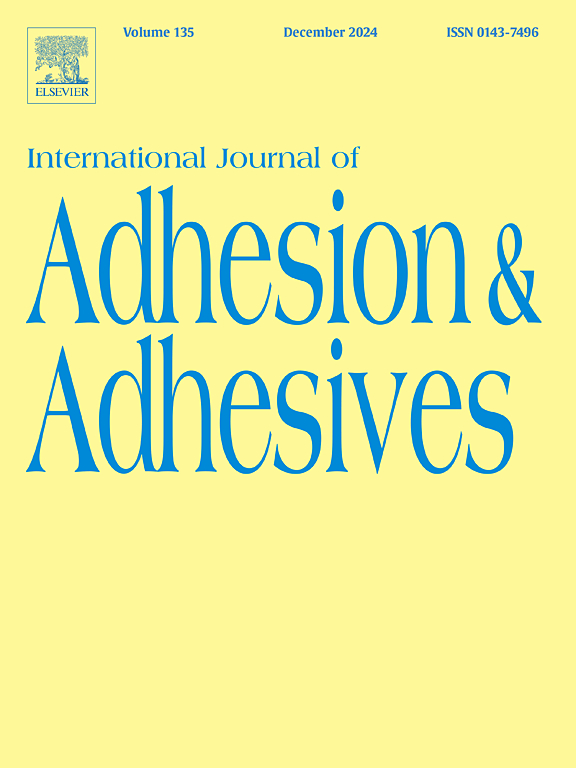Repairability of an alkasite composite: Shear bond strength after different surface treatments
IF 3.2
3区 材料科学
Q2 ENGINEERING, CHEMICAL
International Journal of Adhesion and Adhesives
Pub Date : 2025-03-24
DOI:10.1016/j.ijadhadh.2025.104012
引用次数: 0
Abstract
This study aimed to assess both the repairability of an alkasite composite (base material) and the suitability of an alkasite composite for repairs (repair material) compared to a universal composite used as base and repair material. Different mechanical surface treatments (simulated diamond bur abrasion, air abrasion, silica coating) with or without the additional use of a universal primer were performed. Surface roughness, shear bond strength, and failure modes were assessed. Statistical analysis was performed using ANOVAs, Weibull analysis, and Chi2-tests (p < 0.05). The base material and the mechanical surface treatment impacted surface roughness (both p < 0.001). The base material did not impact repair bond strength (p = 0.129). For both base materials, air abrasion and silica coating resulted in increased surface roughness compared to control (p ≤ 0.014). Only the mechanical surface treatment, the use of a universal primer, and the applied repair material impacted repair bond strength (all p < 0.001). Overall, mechanical surface treatment by air abrasion or silica coating, application of a universal primer, and repairs using the alkasite composite had a beneficial effect on shear bond strength. The base material, the mechanical surface treatment, and the use of a universal primer impacted the distribution of failure modes (all p < 0.001). For both base materials, most cohesive failures were identified after air abrasion or silica coating. Also, the application of a universal primer led to a higher proportion of cohesive failures. Within the limitations of the study, alkasite composite restorations are suitable for repairs using an alkasite composite or a universal composite.
碱石复合材料的可修复性:不同表面处理后的剪切结合强度
本研究旨在评估碱性铝砂复合材料(基础材料)的可修复性和碱性铝砂复合材料(修复材料)与通用复合材料作为基础和修复材料的适用性。进行了不同的机械表面处理(模拟金刚石磨损,空气磨损,二氧化硅涂层),有或没有额外使用通用底漆。评估了表面粗糙度、剪切粘结强度和破坏模式。统计学分析采用方差分析、威布尔分析和chi2检验(p <;0.05)。基材和机械表面处理对表面粗糙度(p <;0.001)。基材对修复粘结强度无影响(p = 0.129)。对于两种基材,与对照相比,空气磨损和二氧化硅涂层导致表面粗糙度增加(p≤0.014)。只有机械表面处理,使用通用底漆,和所应用的修复材料影响修复粘结强度(所有p <;0.001)。总的来说,空气磨损或二氧化硅涂层的机械表面处理,通用底漆的应用,以及使用碱石复合材料的修复对剪切结合强度有有益的影响。基材、机械表面处理和通用底漆的使用影响了失效模式的分布(所有p <;0.001)。对于这两种基材,大多数粘结失效是在空气磨损或二氧化硅涂层后确定的。此外,通用引物的应用导致更高比例的内聚失败。在本研究的限制范围内,碱石复合修复体适用于使用碱石复合材料或通用复合材料进行修复。
本文章由计算机程序翻译,如有差异,请以英文原文为准。
求助全文
约1分钟内获得全文
求助全文
来源期刊

International Journal of Adhesion and Adhesives
工程技术-材料科学:综合
CiteScore
6.90
自引率
8.80%
发文量
200
审稿时长
8.3 months
期刊介绍:
The International Journal of Adhesion and Adhesives draws together the many aspects of the science and technology of adhesive materials, from fundamental research and development work to industrial applications. Subject areas covered include: interfacial interactions, surface chemistry, methods of testing, accumulation of test data on physical and mechanical properties, environmental effects, new adhesive materials, sealants, design of bonded joints, and manufacturing technology.
 求助内容:
求助内容: 应助结果提醒方式:
应助结果提醒方式:


